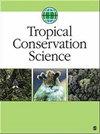马来西亚的豪猪贸易与国际贸易的联系
IF 1.6
4区 环境科学与生态学
Q2 BIODIVERSITY CONSERVATION
引用次数: 0
摘要
背景与研究目的豪猪在亚洲经常被交易,但这方面的证据仍然没有记录。本研究以马来西亚为例,旨在解决豪猪贸易动态信息匮乏的问题。方法为了实现这一目标,研究人员调查了马来西亚全国的传统中药(TCM)销售点,确定了豪猪养殖场的存在,并分析了 2011 年至 2019 年期间马来西亚的豪猪收缴情况。在接受调查的中药店中,90%都发现了豪猪牛肝菌,但市场上可能存在真假产品。豪猪养殖似乎越来越受欢迎,主要是为了满足对种用豪猪的需求。共查获 47 次,110 头豪猪,至少有三个品种。缉获的大部分是活体豪猪,但也有肉和箭。然而,非法捕猎豪猪的现象显然也时有发生。考虑到野生豪猪的高价值,人工繁殖不太可能减少偷猎豪猪的现象。对保护的影响有关东南亚豪猪贸易动态的研究十分有限。这是一个值得关注的保护问题,尤其是豪猪被视为有价值的商品。由于亚洲豪猪面临多种协同威胁(如栖息地丧失、人类冲突和非法狩猎),了解这些因素对野生种群的累积影响是保护工作的当务之急。此外,还需要对国际贸易动态进行更多研究,因为目前的国际贸易没有任何监管或监测。将豪猪列入《濒危野生动植物种国际贸易公约》(CITES)有可能缓解这一问题。本文章由计算机程序翻译,如有差异,请以英文原文为准。
The Trade of Porcupines in Malaysia With International Trade Links
Background and Research AimsPorcupines are frequently traded in Asia but evidence of this remains undocumented. This study was undertaken to address the dearth of information on porcupine trade dynamics using Malaysia as a case study.MethodsTo accomplish this, traditional Chinese medicine (TCM) outlets throughout the country were surveyed, the existence of porcupine farms were determined and porcupine seizures in Malaysia from 2011 – 2019 were analysed.ResultsThe data revealed that porcupines are coveted predominantly for bezoars used in TCM and for breeding stock. Porcupine bezoars were found in 90% of TCM outlets surveyed though it is likely that the market consists of genuine and fake products. Porcupine farming appears to be gaining popularity and predominantly caters to a demand for breeding pairs. There were 47 seizures amounting to 110 porcupines of at least three species. Seizures included mostly live animals but also meat and quills.ConclusionThe harvesting and consumption of porcupines is legally permitted in Malaysia. However, it is evident that illegal hunting of porcupines is also occurring. Captive breeding is unlikely to reduce poaching of porcupines considering the high value associated with wild-sourced bezoars. Local use is also driving international trade of bezoars particularly from Indonesia.Implications for ConservationResearch on porcupine trade dynamics in Southeast Asia is limited. This is a conservation concern particularly as porcupines are valued as commercial commodities. As Asian porcupines face a multitude of synergistic threats ( i.e., habitat loss, human conflict and illegal hunting), understanding these cumulative impacts on wild populations is a conservation priority. More research on international trade dynamics is also warranted as it is currently occurring without any regulation or monitoring. Listing porcupines in the Convention on International Trade in Endangered Species of Wild Fauna and Flora (CITES) could potentially mitigate this.
求助全文
通过发布文献求助,成功后即可免费获取论文全文。
去求助
来源期刊

Tropical Conservation Science
BIODIVERSITY CONSERVATION-
CiteScore
3.60
自引率
5.90%
发文量
16
审稿时长
>12 weeks
期刊介绍:
Tropical Conservation Science is a peer-reviewed, open access journal that publishes original research papers and state-of-the-art reviews of broad interest to the field of conservation of tropical forests and of other tropical ecosystems.
 求助内容:
求助内容: 应助结果提醒方式:
应助结果提醒方式:


